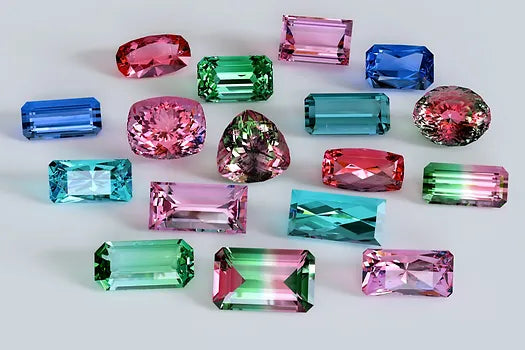Tourmaline stands apart from other gemstones with its broad spectrum of colors in every shade of the rainbow. The stone was first discovered by Dutch traders off the West Coast of Italy sometime in the late 1600’s or early 1700’s. At the time, these green tourmalines were assumed to be emeralds. It wasn’t until the 1800s when scientists realized that these stones were their own species of mineral. The name "tourmaline" comes from the Sinhalese words tura mali, which mean "stone of mixed colors." As its name implies, tourmaline stands apart from other gemstones with its broad spectrum of colors in every shade of the rainbow.
Tourmaline is not one mineral, but a fairly complex group of minerals with different chemical compositions and physical properties. Certain trace elements produce distinct colors, and many resulting varieties have their own names. Many are not Gem quality but some are considered more rare and pricey. Parti-colored tourmaline displays more than one color, due to chemical fluctuations during crystallization. A common color combination is green and pink/red. These are often cut in slices to reveal a dark red center surrounded by a green rim, earning the name “watermelon tourmaline.”
Because of its colorful occurrences, tourmaline has been confused with other gemstones throughout history.
Tourmaline is mined in Brazil, Sri Lanka, Nigeria, Mozambique, Madagascar, Afghanistan, Pakistan and the U.S. primarily Maine and California.
One of this gemstone’s most impressive traits is its ability to become electrically charged through heat and pressure. When charged, tourmaline can act as a magnet by oscillating, and by attracting or repelling particles of dust.
Ancient magicians used black tourmaline as a talisman to protect against negative energy and evil forces. Today, many still believe that it can shield against radiation, pollutants, toxins, and negative thoughts. Tourmaline stands apart from other gemstones with its broad spectrum of colors in every Tourmaline also has many positive attributes in the spiritual realm. It is thought to bring healing powers to a shaman or medicine man. It is what is called a “receptive stone,” which means it is soothing, calming, inward, and magnetic, promoting meditation, spirituality, wisdom, and mysticism. It creates peace and promotes communication between the conscious and unconscious minds, allowing psychic awareness. The traditional Tourmaline Wedding Anniversary is the 8th and,
Tourmaline is a hard crystal which makes it easier to cut and create beautiful jewelry.
American tourmaline deposits caused the gemstone’s spike in popularity. In 1876, mineralogist George Kunz launched a craze when he sold green tourmaline from Maine to Tiffany & Co.
Brazilian tourmaline discoveries in the 1980s and 90s reignited interest in this gemstone, because material mined in Paraíba displayed such striking neon greens, radiant blues, and vivid violets. This region has produced the world’s finest, most valuable specimens of tourmaline—including the world’s largest, weighing 191.87 carats.

Spectacular bright blue to bright green tourmaline, colored by trace amounts of copper, was found in pegmatite pockets at mines in the states of Paraiba and Rio Grande do Norte, Brazil. Later, violet specimens containing traces of both copper and manganese were found. The color of these gems was remarkable. Many people began to describe them with adjectives such as "electric" and "neon" because the colors were so saturated and vivid.
While plenty of tourmaline is mined around the world, it’s rare to find fine gem-quality tourmaline in bright colors.
Disclaimer: This information was gathered and collected from many different sources. We have no copy rights or authority on this information.




